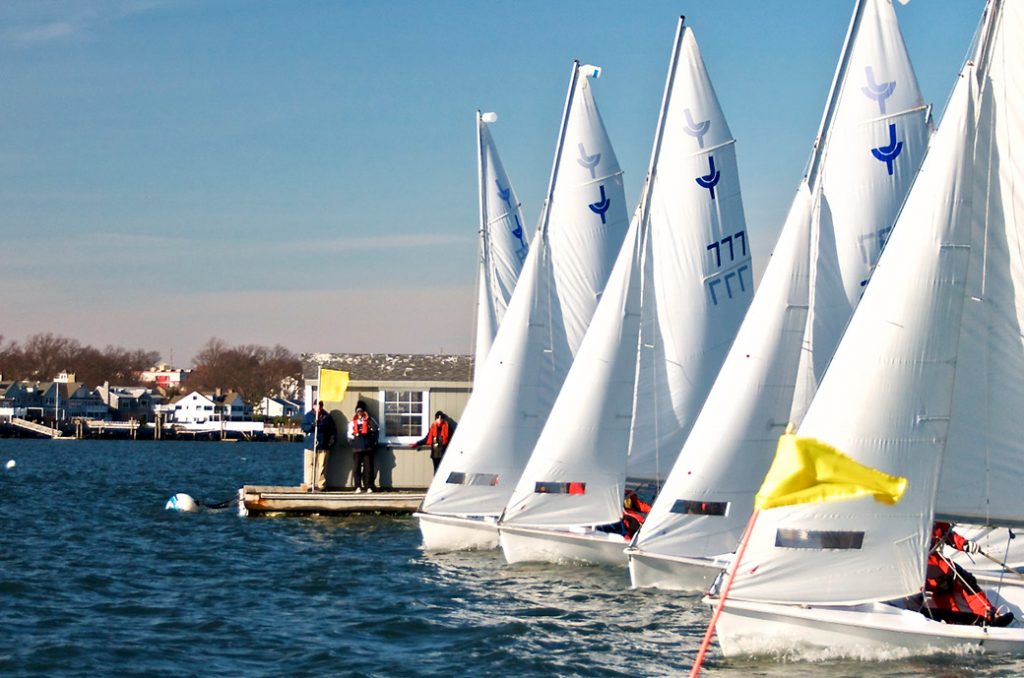By David Dellenbaugh
The goal of your starting tactics is simple – it’s to get yourself into a good position when the race starts. A ‘good position’ is one that allows you to do two main things: 1) Come off the starting line in the front row with speed and clear air; 2) Follow your strategy for the first windward leg.
Tactically, your position at the start must consider two factors – the location of the fleet as a whole and the actions of the boats that are right near you. Both of these will impact your ability to position yourself for a good start. For example, if you start in the middle of a huge pack of boats it may be difficult to get off the line cleanly. Or if there’s another boat close on your lee bow at the start, you will soon get pinched off.
One of the keys to positioning at the start is the ability to handle your boat well in close quarters. In a dinghy you must be able to hold your boat in place for quite a long time, turn your boat without moving forward and accelerate from zero to full speed in as short a time as possible. In big boats, you need a good sense of time and distance.
Many of these boathandling skills are things you and your crew can practice on your own. Find a buoy, for example, and see how long you can hold your boat in position right next to it. Then sail away from the buoy, start a countdown, and try to reach the buoy at full speed when your watch hits zero. Good boathandling requires teamwork and a fair bit of practice.
As I mentioned before, knowledge of the racing rules is also key to the execution of starting tactics. Tactics, by definition, involve boat-to-boat maneuvers, and it’s difficult to be confident about these if you don’t fully understand your rights and obligations under the rules.
Fortunately, the rules are one sailing subject that you can learn without having to be on the water all the time. Set a goal for this winter of learning all the rules that apply at the starting line. Study the rulebook, read books about the rules (I recommend Dave Perry’s Understanding the Racing Rules of Sailing Through 2024) and find chances to talk with people who know a lot about the rules.

A common mistake, often made by less experienced racers, is getting to the line too soon. You definitely want to be near the line at the start, but if you’re too close before the gun the only way you can build speed is by sailing on a close or beam reach.
© Rick Bannerot/PntheflyPhoto.net
Besides smooth boathandling skills and a thorough understanding of the rules, getting yourself into a good position at the start requires the ability to execute some basic tactical moves. Here are a few rules of thumb when you are approaching the start:
• Line up on starboard tack. We take this for granted because almost everyone does it. But there is a very solid tactical reason here – boats on starboard tack have the right of way. Yes, there are times when a port tack start will work (be sure to look for those), but most of the time it’s better to go with the flow by making your final approach on starboard.
• Luff on a closehauled course. When you are sitting on the line, luffing and going slowly, keep your boat on an angle that is about 40° or 45° to the wind. This way you can trim in and start accelerating without the need to turn your boat or your rudder (both of which take time and slow you down).
• Avoid boats close to leeward. You should never start a race with a boat close to leeward (if you can possibly avoid it), so carve out a hole on your leeward side and guard it as you approach the line. The size of the hole you need is at least half a boatlength or so, but depends on a number of factors including wind strength, waves, line angle and your type of boat.
• Start with your bow even. Unless you know the boats around you are over the line early, you should always start the race with your bow even or ahead of theirs. The most common error here is not accelerating until it’s too late, so keep an eye on the boats nearby and be ready to trim in when they do. From a tactical point of view, it’s important to anticipate what may happen and to be flexible about how you respond. If you’re stuck in a pack with 45 seconds to go, for example, don’t be afraid to bail out and find another hole. ■
This article originally appeared in David Dellenbaugh’s Speed & Smarts, The newsletter of how-to tips for racing sailors. If you want to sail faster and smarter, log onto SpeedandSmarts.com.
